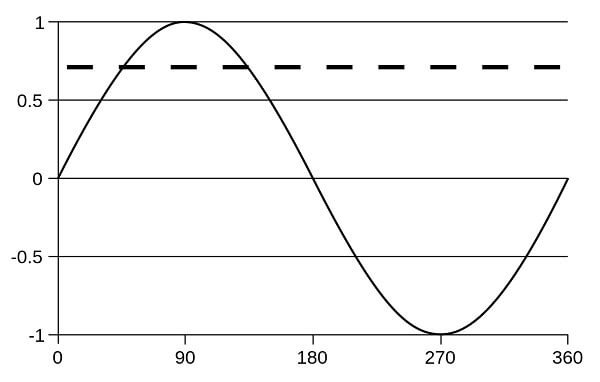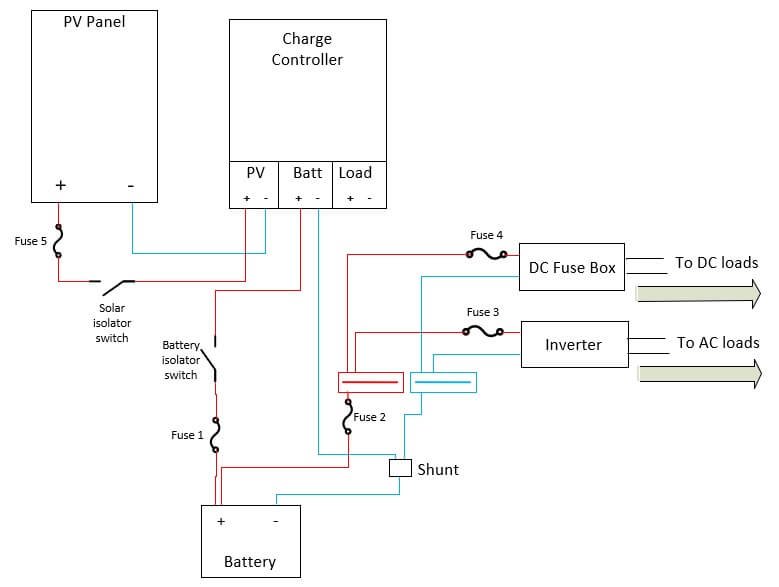When you are looking to purchase a pure sine wave inverter, you might come across other devices like a modified sine wave.
In this article, I will tell you what a pure sine wave inverter is and why it is more expensive than a modified sine wave.
What does Pure Sine Wave Mean?
You would find a sine wave in any AC (alternating current) device. In DC (direct current), there is no sine wave.
In an off-grid solar system, we want to convert the DC power into an AC signal to use for our appliances.
We do this by connecting the battery terminals to the input of the inverter.
The battery can be 12, 24, or even 48 Volts. The power inverter needs to be able to accept this voltage. Some power inverters have multiple input voltages, which you can adjust once you know the voltage of your battery.
In the following image, you will see the DC signal:

You can see that the DC signal stays positive. It can also be negative, but it will stay either positive or negative. It doesn’t switch sides.
In AC, the signal switches sides as you can see in the following image:

In the image, we can see that the sine wave is very clean; that’s why it’s called a pure sine wave. The sockets in your house have this kind of sine wave.
Cheaper options like a modified sine are not as clean as this signal. Ideally, you want a pure sine wave inverter to power your AC loads.
Do You Need a Pure Sine Wave Inverter?
As previously discussed, pure sine wave inverters are the most expensive option. Modified sine wave inverters are much cheaper.
That begs the question: Do I need a pure sine wave inverter?
What devices need a pure sine wave?
Some devices require a pure sine wave inverter to work properly. These are:
- TV’s
- Microwaves
- Chargers for laptops, tablets, desktops
- Delicate electronics
- Audio installation
Running devices on a modified sine wave will be less efficient than a pure sine wave inverter. This is because the electronics will tend to run hot trying to use the modified sine wave. You can also hear a buzzing sound when you use modified sine waves.
If you don’t like to overheat your devices or hear a potential buzzing sound, I recommend using a pure sine wave inverter all the time, even if they are two to three times more expensive.
Wiring a pure sine wave inverter
You should wire the positive and negative of the inverter to the main battery terminals or busbar. You can only add a maximum of 3 cables to one battery stud, according to the guidelines. The less, the better.
In the following diagram, you can see how you should wire the inverter.

I have gotten many questions about what kind of batteries people need for different kinds of inverters. I have made a few articles where I go more in-depth on this topic. You can read them here:
- How many Batteries for a 1000 watt inverter
- How Many Batteries for a 2000 watt Inverter
- How Many Batteries for a 3000 watt Inverter
Conclusion
A pure sine wave inverter converts the DC signal to a usable AC signal for your 110 or 230 Volt devices.
It’s better to get a pure sine wave inverter instead of a modified sine wave inverter.
I hope this article has answered your question about what a pure sine wave inverter is.
I recommend reading my article about the best off-grid inverters.
If you have questions, send me an email or leave a comment.
 I have written a book that contains all the information you need to get started with off-grid solar power.
I have written a book that contains all the information you need to get started with off-grid solar power.
With over 1,300 reviews at 4.5 stars, I can almost guarantee that this book will save you $ 100’s on buying the right equipment.
You can buy it here on Amazon.com

I’m an off-grid enthusiast. I created this website to give clear and straight-to-the-point advice about solar power. I’m also the author of the book ‘Off-grid solar power simplified‘. Read more about me on my about page, check out my Youtube channel, or send me a message.
i like and understand wht u are saying u done it in step i got what u saying no hard thanks for the adive
Super helpful in breaking down what can seem like a pretty technical topic! It’s great how they explained the difference between pure and modified sine waves with those visuals; it really makes it click why pure sine wave is the way to go for sensitive electronics. Definitely learned a thing or two about keeping my gadgets happy and humming smoothly with clean power. Thanks for sharing this!